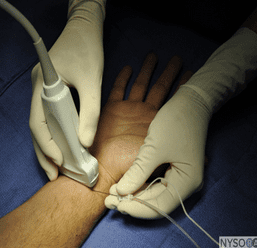What is Carpal Tunnel Syndrome?
As the median nerve gets compressed, it causes intermittent pain, numbness and tingling in the first three digits and sometimes the ring finger too. The numbness often is typically more noticeable at night, possibly related to sleep position. Patients frequently awaken at night and shake their hands to relieve these symptoms. As symptoms progress, the pain may extend up towards the arm and it will be perceived as shoulder or forearm pain. CTS may progress to involve the motor fibers leading to difficulty using the fingers and causing weakness of hand grip.
CTS can be associated with many medical conditions that cause pressure on the median nerve at the wrist, such as arthritis, pre-diabetes (impaired glucose tolerance), diabetes, thyroid dysfunction, or trauma.
Indication for Injection
Patients with signs and symptoms that correlate to CTS must have an electrodiagnostic study (Nerve conduction study and EMG) to confirm the diagnosis by a highly specialized and fellowship-trained neurologist such as Dr Yono and Dr Kashouty. Ultrasound is also used to inspect the anatomy of the wrist at the carpal tunnel and to exclude other diseases.
Unless there is an urgent need for surgery, treatments such as wrist splints and corticosteroid injections are recommended initially to relieve the symptoms of CTS. Corticosteroids are a type of steroid medication, which are naturally produced hormones in the body. Carpal tunnel steroid injection has been shown in many research studies to relieve the symptoms of pain and tingling sensation, and is an effective treatment and may last up to one year.
One injection is usually recommended to begin with. If the condition responds well to one injection but then recurs, the treatment may be repeated again. The benefit of using steroid injection is to lower the local inflammation in the wrist around the median nerve and also has powerful local anti-inflammatory agent to reduce the swelling and pain.
Benefit of Ultrasound-Guided Injection
Typically a carpal tunnel injection is often performed blindly, which increases the risk of damaging the median nerve and the surrounding vulnerable structures such as tendons and blood vessels.
To improve accuracy of the procedure, image-guided injections are required. Ultrasound technology is rapidly evolving and the use of it in a variety of neuromuscular diseases is expanding. The use of neuromuscular ultrasound is a non-invasive and cost-effective technique. It is a safe imaging modality. It has multiple advantages over other imaging methods including relative portability, lack of ionizing radiation, high resolution, and short test duration. It has become the first choice to guide carpal tunnel injections.
Ultrasound-guided technique provides an anatomic high-resolution image of the median nerve, the carpal tunnel and the neighboring structures. It provides a clear advantage in guiding carpal tunnel injections because it enables visualizing the needle tip continuously and ensures that the needle is placed precisely in the desired location, avoiding the risk to damage the surrounding structures.
Post Procedure Care
There is no specific test preparation. The procedure is very short in duration, on average it takes about 15 to 20 minutes. Normal activities may be resumed after the procedure, however patient will be instructed to take it easy for the rest of the day, and to place ice pack on the injected site if pain persists. A return office visit appointment will be made in few weeks for follow up. The patient is also encouraged to call at any time if any problems occur.




